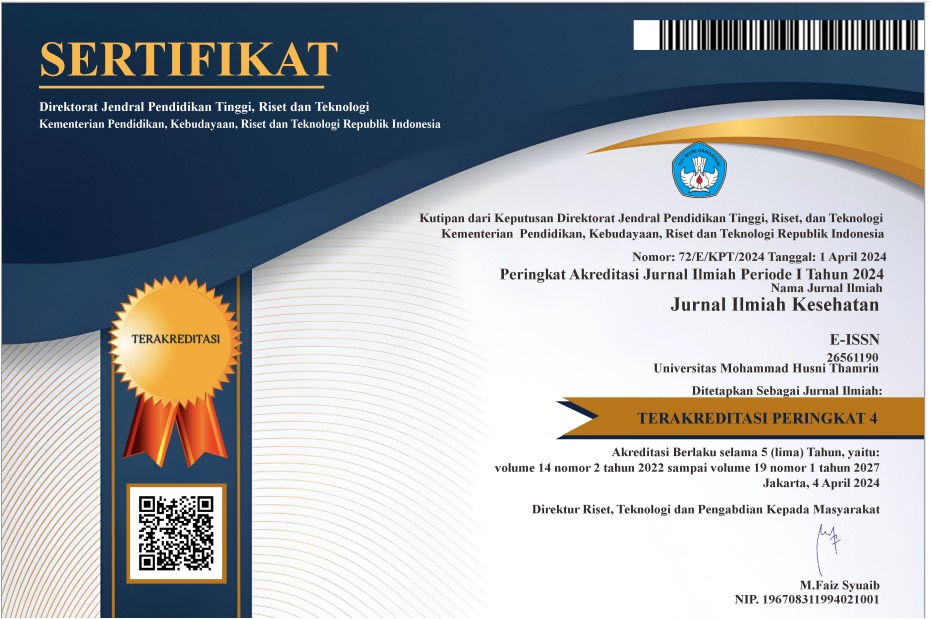Identifikasi Mikroplastik Pada Sedimen di Perairan Sungai Musi Wilayah Kabupaten Banyuasin
DOI:
https://doi.org/10.37012/jik.v16i2.2309Keywords:
Mikroplastik, Sedimen, Sungai Musi, Desa Upang MargaAbstract
Mikroplastik berbahaya bagi kesehatan karena sifat karsinogenik nya. Mikroplastik dengan ukuran lebih besar atau cenderung berat itu mudah mengendap di dasar perairan. Tujuan dari penelitian yang dilakukan yaitu untuk mengidentifikasi mikroplastik pada sedimen di perairan sungai musi wilayah Kabupaten Banyuasin dan juga kurangnya data membuat penelitian ini penting untuk dilakukan. Penelitian ini bersifat deskriptif analitik dengan penetapan titik lokasi sampel air secara purpossive sampling sebanyak 250-500 gram pada bagian dasar perairan dengan 3 kali pengulangan. Hasil penelitian menunjukkan bahwa dalam 100 ml sampel sedimen ditemukan variasi mikroplastik yang berbentuk film (1 partikel), fiber (1 partikel), dan fragmen (4 partikel). Bentuk mikroplastik yang lebih sering ditemukan yaitu fragmen sebanyak 4 partikel. Variasi warna mikroplastik yaitu warna hitam, coklat dan merah muda, dengan warna mikroplastik yang lebih sering ditemukan adalah warna coklat dengan jumlah 4 partikel. Untuk ukuran mikroplastik diperoleh sebanyak 6 ukuran, dari yang terkecil yaitu fragmen berukuran 650,90 μm sampai dengan yang terbesar yaitu fragmen berukuran 1884,15 μm. Identifikasi mikroplastik pada sedimen di Perairan Sungai Musi (hilir) wilayah Kabupaten Banyuasin menunjukkan variasi mikroplastik berbentuk fiber, film dan fragmen. Analisis menunjukkan bahwa warna mikroplastik terdiri dari berbagai warna diantaranya hitam, coklat dan merah muda dengan warna mikroplastik yang lebih sering ditemukan yaitu warna coklat dengan jumlah 4 partikel. Untuk rata-rata ukuran dari 6 partikel mikroplastik yaitu 1062,03 μm.
References
Aritonang, A. A., Surbakti, H., & Purwiyanto, A. I. (2016). Laju Pengendapan Sedimen di Pulau Anakan Muara Sungai Banyuasin Provinsi Sumatera Selatan. Maspari Journal: Marine Science Research, 8(1), 7-14.
Li, Y., & Wang, B. (2021). Go green and recycle: Analyzing the usage of plastic bags for shopping in China. International Journal of Environmental Research and Public Health, 18(23), 12537.
Joesidawati, M. I. (2018). Pencemaran mikroplastik di sepanjang pantai kabupaten Tuban. Prosiding SNasPPM, 3(1), 8-15.
BPS. (2023). Statistik Lingkungan Hidup Indonesia 2023.
Chatterjee, S., & Sharma, S. (2019). Microplastics in our oceans and marine health. Field Actions Science Reports. The Journal of Field Actions, (Special Issue 19), 54-61.
Lim, X. (2021). Microplastics are everywhere—but are they harmful. Nature, 593(7857), 22-25.
Jassim, A. K. (2023). Effect of microplastic on the human health. In Advances and Challenges in Microplastics. IntechOpen.
Sulistyo, E. N., Rahmawati, S., Putri, R. A., Arya, N., & Eryan, Y. A. (2020). Identification of the existence and type of microplastic in code river fish, special region of Yogyakarta. EKSAKTA: Journal of Sciences and Data Analysis, 85-91.
Browne, M. A. (2015). Sources and pathways of microplastics to habitats. Marine anthropogenic litter, 229-244.
Nor, N. H. M., & Obbard, J. P. (2014). Microplastics in Singapore’s coastal mangrove ecosystems. Marine pollution bulletin, 79(1-2), 278-283.
Hambali, R., & Apriyanti, Y. (2016, December). Studi Karakteristik Sedimen dan Laju Sedimentasi Sungai Daeng–Kabupaten Bangka Barat. In FROPIL (Forum Profesional Teknik Sipil) (Vol. 4, No. 2, pp. 165-174).
Wright, S. L., Thompson, R. C., & Galloway, T. S. (2013). The physical impacts of microplastics on marine organisms: a review. Environmental pollution, 178, 483-492.
Rochman, C. M., Tahir, A., Williams, S. L., Baxa, D. V., Lam, R., Miller, J. T., ... & Teh, S. J. (2015). Anthropogenic debris in seafood: Plastic debris and fibers from textiles in fish and bivalves sold for human consumption. Scientific reports, 5(1), 1-10.
Ryan, P. G., Moore, C. J., Van Franeker, J. A., & Moloney, C. L. (2009). Monitoring the abundance of plastic debris in the marine environment. Philosophical Transactions of the Royal Society B: Biological Sciences, 364(1526), 1999-2012.
Joesidawati, M. I. (2018). Pencemaran mikroplastik di sepanjang pantai kabupaten Tuban. Prosiding SNasPPM, 3(1), 8-15.
Cordova, M. R., & Wahyudi, A. A. J. (2016). Microplastic in the deep-sea sediment of Southwestern Sumatran Waters. Marine Research in Indonesia, 41(1), 27-35.
Putri, W. A. E., Purwiyanto, A. I. S., Agustriani, F., & Suteja, Y. (2019). Kondisi nitrat, nitrit, amonia, fosfat dan BOD di Muara Sungai Banyuasin, Sumatera Selatan. Jurnal Ilmu dan Teknologi Kelautan Tropis, 11(1), 65-74.
Ridlo, A., Ario, R., Maa’ruf Al Ayyub, A., Supriyantini, E., & Sedjati, S. (2020). Mikroplastik pada Kedalaman Sedimen yang Berbeda di Pantai Ayah Kebumen Jawa Tengah. Jurnal Kelautan Tropis, 23(3), 325-332.
Löder, M. G., & Gerdts, G. (2015). Methodology used for the detection and identification of microplastics—a critical appraisal. Marine anthropogenic litter, 201-227.
Kingfisher J. (2010). Microplastic Debris Accumulation on Puget Sound Beaches. Port Townsend Marine Science Center.
Azizah, P., Ridlo, A., & Suryono, C. A. (2020). Mikroplastik pada Sedimen di Pantai Kartini Kabupaten Jepara Jawa Tengah. Journal of marine Research, 9(3), 326-332.
Tunçer, S., Artüz, O. B., Demirkol, M., & Artüz, M. L. (2018). First report of occurrence, distribution, and composition of microplastics in surface waters of the Sea of Marmara, Turkey. Marine pollution bulletin, 135, 283-289.
GESAMP. (2015). Sources, Fate and Effects of Microplasrics in the Marine Oceans: a global assessment. International Maritime Organization, London.
Kapo, F. A., Toruan, L. N., & Paulus, C. A. (2020). Jenis dan kelimpahan mikroplastik pada kolom permukaan air di perairan Teluk Kupang. Jurnal Bahari Papadak, 1(1), 10-21.
Pradiptaadi, B. P. A., & Fallahian, F. (2022). Analisis kelimpahan mikroplastik pada air dan sedimen di Kawasan Hilir DAS Brantas. Environmental Pollution Journal, 2(1).
Claessens, M., De Meester, S., Van Landuyt, L., De Clerck, K., & Janssen, C. R. (2011). Occurrence and distribution of microplastics in marine sediments along the Belgian coast. Marine pollution bulletin, 62(10), 2199-2204.
Yona, D., Samantha, C. D., & Kasitowati, R. D. (2021). Perbandingan kandungan mikroplastik pada kerang darah dan kerang tahu dari perairan Desa Banyuurip, Gresik. Saintek Perikanan: Indonesian Journal of Fisheries Science and Technology, 17(2), 108-114.
Lutfi, M., Asih, A. Y. P., Wijaya, S., & Ibad, M. (2023). Literature Review: Mikroplastik Pada Berbagai Jenis Kerang Serta Dampak Terhadap Kesehatan. Journal of Comprehensive Science (JCS), 2(5), 1325-1334.
Mauludy, M. S., Yunanto, A., & Yona, D. (2019). Microplastic abundances in the sediment of coastal beaches in Badung, Bali. Jurnal Perikanan Universitas Gadjah Mada, 21(2), 73-78.
Yona, D., Di Prikah, F. A., & As’adi, M. A. (2020). Identifikasi dan perbandingan kelimpahan sampah plastik berdasarkan ukuran pada sedimen di beberapa pantai Kabupaten Pasuruan, Jawa Timur. Jurnal Ilmu Lingkungan, 18(2), 375-383.
Nugroho, D. H., Restu, I. W., & Ernawati, N. M. (2018). Kajian kelimpahan mikroplastik di perairan teluk benoa Provinsi Bali. Current Trends in Aquatic Science, 1(1), 80-88.
Downloads
Published
How to Cite
Issue
Section
Citation Check
License
Copyright (c) 2024 Siti Aisyah Umayah, Yuanita Windusari

This work is licensed under a Creative Commons Attribution 4.0 International License.
Jurnal Ilmiah Kesehatan allows readers to read, download, copy, distribute, print, search, or link to the full texts of its articles and allow readers to use them for any other lawful purpose. The journal allows the author(s) to hold the copyright without restrictions. Finally, the journal allows the author(s) to retain publishing rights without restrictions Authors are allowed to archive their submitted article in an open access repository Authors are allowed to archive the final published article in an open access repository with an acknowledgment of its initial publication in this journal.

Lisensi Creative Commons Atribusi 4.0 Internasional.










